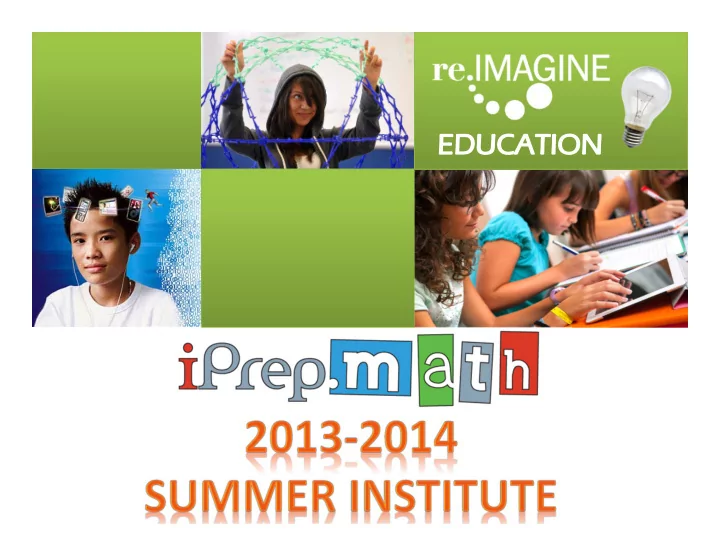

DO YOU RECOGNIZE ME? THE DIGITAL NATIVE The Digital Native Video “Students are more and more visually literate. They live in a world filled with technology and visual input.” ‐ Patricia Nuñez, Palm Springs Middle School
• 21 st century personalized and blended learning environment • 49 traditional middle schools • Approximately 11,800 middle school students across Miami-Dade County Public Schools in grades 6, 7, and 8 • Choice-driven program with voluntary participation of schools, teachers, and students • Doors open in the fall of 2013-2014 • Curriculum aligned with the goals of the Common Core State Standards in Mathematics (CCSSM) with a blended curriculum for year one of NGSSS and CCSSM • Wrap-around services provided to students through academic and behavioral counseling programs • College and career preparation skills provided by ConnectEDU to all students in the school • Model implementation fidelity monitored through External Evaluators
RE ‐ IMAGINE CLASSROOMS Learning Hubs
Re ‐ imagine YOUR Classroom
Project ‐ based Small Group Activities Intervention Student Collaboration Adaptive Software Student ‐ Centered teaching INDIVIDUAL STUDENT LEARNING
“My philosophy of education is that I am a facilitator of knowledge. It is my job to provide a learning environment where all students will learn, succeed, and improve their level of achievement…” ‐ Josefa Alfonso, Arvida Middle School
Student access to Highly Effective and Effective Teachers Access to all students, regardless of mathematical abilities Differentiated learning through adaptive software technology Part ‐ time interventionist to provide small group, explicit instruction Reflex software to increase math fluency Address behavioral and academic barriers through counseling services and outside resources Expose middle school students to college and career planning
The 21st Century Learner Video • From teacher ‐ centered to student ‐ centered “because when students have access to the same amount of information as a teacher, teaching has to change” • From an “explainer ‐ in ‐ chief to more of an orchestrator of learning ” • Masters of their content where “the teachers who have been the most successful [in a digital classroom] didn’t necessarily know anything about technology” • View “students as a team and often rely on their expertise [in technology] to help fill in the gaps” • Help students evaluate information to “help them figure out what’s true, what’s relevant, what’s accurate” on the Internet • Create “a more complex learning environment , because students can do much of their own work” • A connected educator who is “comfortable with collaborative learning, social media, and sharing ideas online”
10%
70%
20%
COMPONENTS OF THE INSTRUCTIONAL FRAMEWORK Students Spend Most of Students Can Students Take the Request Explicit Part in Project Instructional Instruction via Based Learning Time Workshop or (PBL) Investigating Teacher Can Pull Students are a Data Driven Guided by Small Group Essential Questions and Students Reflect Modules and Review the Day’s Progress Daily Pulling Team Teachers of Data With the are Roaming teacher(s) Conductors Student Groupings are and Facilitators Data Driven (
ELEMENTS OF COMMON PLANNING: PLAN iPlan
ELEMENTS OF COMMON PLANNING: PLAN iPlan • Daily Pulling and Disaggregation of Data • Group Students Based on Data (WWW form) • Planning of Project Based Learning Activities • Planning of Modules • Alignment of Pacing Guides to Modules • Planning of Team Teaching Roles
PLANNING FOR INVESTIGATION: MODULE
PLANNING FOR INVESTIGATION: MODULE
PLANNING FOR INVESTIGATION: MODULE
PLANNING FOR INVESTIGATION: WHAT: THE INITIAL ACTIVITY THE TEACHER(S) SELECTS THE STUDENT(S) TO BEGIN WITH WH0: WHICH STUDENTS WILL BEGIN ON THE INITIAL ACTIVITY SELECTED BY THE TEACHER(S) WHY: WHAT DATA WAS USED (QUANTITATIVE OR QUALITATIVE) TO DRIVE THE DECISIONS OF INITIAL PLACEMENT AND GROUPINGS
PLANNING FOR INVESTIGATION:
STUDENT SELF ‐ GUIDING TOOLS FOR INVESTIGATION
DIGITAL CLASSROOM “LOOK FORS” 1. VOICE – Learners have the opportunity to not only learn from others but also share their learning with others. 2. CHOICE – Learners choose how they learn, and what they will learn about. 3. TIME FOR REFLECTION – Learners have time to connect and reflect on what is being learned to give them a better opportunity to have a deeper understanding. 4. OPPORTUNITIES FOR INNOVATION – Learners are creating things that are new and better 5. CRITICAL THINKERS – Learners are able to ask questions and challenge what they see, but always in a respectful way. 21st Century Education.mp4
DIGITAL CLASSROOM “LOOK FORS” 6. PROBLEM SOLVERS/FINDERS – Learners are given opportunities to find tough challenges and then are able to solve those problems. 7. MULTIPLE OPPORTUNITIES FOR MASTERY – Students are given opportunities to re ‐ do tasks, and teachers plan for re ‐ teaching/remediation experiences 8. SELF ‐ ASSESSMENT – Teachers spend more time working with students to teach them how to assess themselves and not just do it for them. 9. CONNECTED LEARNING – Learners connect to learning opportunities outside of the classroom via Skype, the Internet, etc. From “Connected Principals,” Jan. 2013
Personalized Learning Open space Blended classroom Learning environment iPrep Math Common Adaptive Core Software Standards 21 st Century Skills
Lisette Alves Executive Director lalves@dadeschools.net 305 ‐ 995 ‐ 7292 Jessica Fortich Erik Gonzalez iPrep.Math Facilitator iPrep.Math Facilitator jfortich@dadeschools.net erikgonzalez@dadeschools.net Olema Herrera Ilia Molina iPrep.Math Facilitator iPrep.Math Facilitator olemaherrera@dadeschools.net iliaperez@dadeschools.net Caridad Hidalgo Susan Hansen iPrep.Math Student Services Support iPrep.Math Student Services Specialist Support Specialist hidalgoc@dadeschools.net shansen2@dadeschools.net
Recommend
More recommend